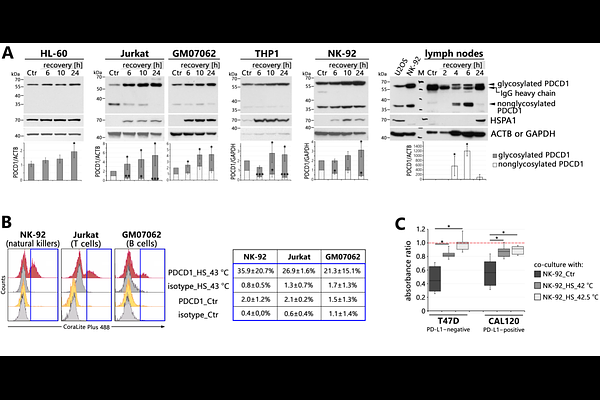PDCD1 expression increases at elevated temperatures.

PDCD1 expression increases at elevated temperatures.
Toma-Jonik, A.; Janus, P.; Mrowiec, K.; Vydra, N.; Sarkowicz, K.; Bar, M.; Mirek, J.; Olbryt, M.; Fidyk, W.; Widlak, W.
AbstractPDCD1 (Programmed cell death protein 1) is an immune checkpoint that inhibits the excessive response of antigen-activated T cells to prevent autoimmune tissue damage. In chronic infections or cancers, lasting antigen exposure leads to permanent PDCD1 expression that can limit immune-mediated clearance of pathogens or degenerated cells. Consequently, blocking PDCD1 can enhance T cell function, which is the basis of cancer immune checkpoint therapy. We found that PDCD1 expression (mRNA and protein) can increase within hours of temperature elevation in human leukemic and lymphoblastoid cell lines (such as Jurkat, THP1, HL-60, GM07062, and NK-92) and mouse lymphoid organs (e.g., thymus, spleen, and lymph nodes). Transcriptional upregulation of the PDCD1 gene was associated with the binding of heat shock factor 1 (HSF1) to the promoter, and HSF1 knockout in HL-60 cells resulted in reduced PDCD1 activation. Furthermore, heat shock-dependent increase in glycosylated (and therefore active) PDCD1 protein levels was associated with PDCD1 exposure on the cell membrane and a reduction in the cytotoxic properties of NK-92 cells. Our observations suggest that the immune response could be attenuated in various physiological conditions accompanied by increased temperatures (infection, heat stroke, etc.). This observation may have clinical implications, and therefore, further research is warranted to understand the importance of fever and PDCD1 in various disease states, as well as their interaction with treatment.